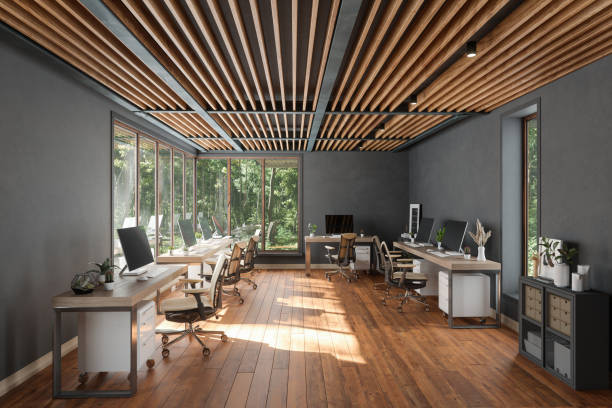Achieving an appropriate sound in big rooms, let alone halls, is the goal of noise control to avoid having echoing acoustics. When it comes to PA systems, home theaters, meeting rooms or studios, proper DIY approaches can play an essential role in improving the room acoustics very effectively and within the least expense possible. Herein, are numerous, rather simple yet efficient DIY solutions that can be used to enhance the acoustic in large spaces such as rooms and halls.
Understanding Acoustics in Large Spaces:
Acoustics in large rooms and large volume rooms are quite different from the small ones and relatively small spaces. Such waves tend to spread and reflect off surfaces forming echoes and reverberations within a much shorter time. Installing acoustic tiles or panels on the ceiling can significantly improve acoustics in large rooms and halls. Start searching for suspended ceiling near me to enhance sound quality and reduce reverberation. To offset these effects, it is necessary to strategically place sound-absorbing objects in rooms according to the design principles outlined above.
Strategic Furniture Arrangement:
Furniture pieces can occupy roles which are beyond being simple objects: it can be acoustic treatment as well. Many new furniture pieces such as bookcases, sofas, or cabinets produce large flat surfaces that can impact sound and make it crisper. Place such items differently in the room and separate them to reduce sound bouncing off the walls and floors, and diversify the sound echo.
DIY Bass Traps:
In large rooms and halls, bouncing or what is referred to as bass frequencies or low frequencies presents more of a challenge. Other resonant frequencies can be dealt with through absorption or diffusion by DIY bass traps. Cubbyholes are generally installed in some areas of a room, where bass build up is most likely to be observed. These can be assembled from either the rigid fiberglass insulation or inscribed bass-frequency-amplifying foam that is coated with fabric of the chosen color and texture of the room.
Ceiling Treatments:
One can observe that ceilings are frequently ignored when it comes to dealing with acoustics problems of real large rooms. They do not contribute much to the frequency of sound absorption but they are very important in the process of reverberation. The use of hanging tiles or panels on the ceiling has a great impact on the environment and reduces the noise by embracing those waves that otherwise would have reflected on the healthier surfaces.
Sound Diffusers:
Another technique employed as strategies for enhancing acoustics in large spaces include diffusion. They are also known to release sound energy in different patterns and hence the no sound energy accumulates in a certain area. Common materials used for constructing DIY diffusers include wood or plastic and efficiency is enhanced by designing specific patterns for the diffuser. Thus, for the best effect, you should place diffusers on walls that are at the rear of the sound origin.
DIY Sound Absorption Panels:
Probably the most efficient way one can boost the room sound quality is by constructing sound absorption panels on own. These panels are usually made from some denote such as acoustic foam, fiberglass, mineral wool and the likes, covered with fabric. It hampers sound waves from echoing in the room or bouncing from different surfaces with in the room. Hang them on walls or ceiling sections with most reflected light because these can be positioned behind speakers or on the sidewalls of the room. Additionally, when installing panels, using a stud track system can provide a sturdy framework and ensure that the panels are securely mounted.
It is also important to note that enhancing sound quality in large rooms and halls can be easy and simple. Below are some DIY ideas that when applied can help in enhancing acoustics: Sound absorption panels, Furniture placement, DIY bass traps, ceiling treatment, and Sound diffusers. For a home theater, an office meeting room, or an audio recording booth, some basic acoustics knowledge and these abovementioned solutions will help reduce echo and have better sound quality. Try out these techniques to identify which techniques you want to have for your space and which ones will best improve your audio experience.




21 comments
Lorem, I really appreciated the practical tips here. The advice on choosing finishes and measurement accuracy felt useful for any home project, and it sparked new ideas for organising storage efficiently kitchen cabinet uk.
Great post! I appreciate practical tips and friendly guidance that make projects feel doable, even when tackling bigger upgrades. Sharing a few personal wins always helps others stay motivated and on track door replacement toronto.
Loved this post and the ideas shared. Practical tips, thoughtful details, and a friendly tone make it easy to picture upgrading my space with confidence and clarity custom kitchen design and build services UK.
I really enjoyed this post and found the tips thoughtful and practical for daily adventures. The storytelling style kept me engaged, and I appreciated the practical insights for planning memorable journeys vintage tissue.
Great insights in this post. I love how thoughtful details can transform outdoor spaces, from thoughtful plant choices to low-maintenance options that still boost curb appeal and usability for any yard Rocklin Landscaping.
Great insights on project longevity and maintenance tips. It’s refreshing to see practical advice that emphasises proper drainage, quality materials, and regular inspections to keep surfaces looking great for years asphalt paving company in south florida.
I love the warm, vintage feel these pieces bring to a room; the colours are rich, and the patterns feel timeless, making any space feel more inviting and unique with a handmade touch handmade Oushak rug designs.
This post really helped me think through DIY options that balance security and style. Practical tips and clear steps make tackling similar projects feel doable even for beginners cat flap installation glass door.
Great post—really insightful tips on reducing energy use and improving comfort. I appreciate practical suggestions that are easy to implement, plus the reminder to consider reputable efficiency upgrades for long‑term savings Seai Energy Savings.
I appreciate how thoughtful energy-saving upgrades can be for any home, especially the long-term comfort and consistent insulation they provide during seasonal shifts and busy household routines low e double glazed windows.
This post really inspired my latest decorating idea, and I loved how the visuals tie the room together with a warm, personalised touch that feels both stylish and welcoming d horse wall art.
I really enjoyed this post and found the ideas genuinely practical for upgrading a space with classic warmth, while keeping things efficient and stylish. Thanks for sharing thoughtful guidance and tips Cast Iron Style Radiators.
Great post! I recently compared local experts and appreciated practical advice on budgeting and scheduling. It’s reassuring to find professionals who prioritise safety, clear communication, and reliable follow-up after services Plumbing contractor in Noida.
Great post—really appreciated the practical tips and thoughtful approach. It’s refreshing to see guidance that balances safety with efficiency, especially for someone planning minor upgrades at home this season Electrical contractor in Noida.
As a fellow homeowner, I appreciate practical tips and friendly advice that make repairs feel manageable and affordable for everyone, especially when weather worries begin to pile up roof repair dallas tx.
Great post! It’s always reassuring to hire trusted professionals who explain options clearly, offer transparent timelines, and stand by their workmanship with solid warranties. A thoughtful approach makes any upgrade feel worthwhile and stress-free Roofing Installer in Arizona.
I really appreciate the thoughtful tips in this post; practical ideas and friendly guidance help me plan smarter upgrades without breaking the bank. Looking forward to more helpful insights and real-world examples contact River Hills Homes for a consultation.
This thoughtful post really highlights practical bathroom updates that blend style with everyday use. I appreciate the focus on durability and simple design that keeps a space tidy and inviting Buy GROHE Toothbrush Holder with Glass.
I loved how the post highlights practical, space-smart ideas that work for urban living. It’s refreshing to see thoughtful design that balances charm with efficiency and endurance in smaller homes tiny homes boston.
Love seeing expert tips on making spaces feel cohesive and functional. The ideas here are practical, approachable, and inspire creative thinking for any project, big or small, with thoughtful attention to detail interior rendering service.
I recently updated my entryway and’m really impressed by the quality and service I found locally. The installers were patient, tidy and clearly explained options that fit my budget and style storm door companies near me.